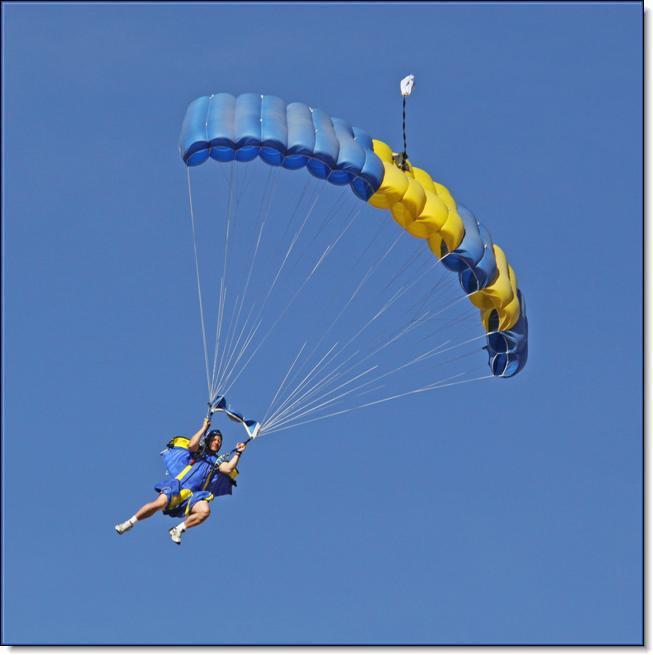Recommended Posts
AFFI 0
\QuoteThe question being "how long does it take to reach terminal velocity"?
Right, you asked for this one. Anyone who's scared of equations, look away NOW.
Still here? Good. You're a nerd.
EQUATIONY BIT (with the explanation - skip to discussion if this stuff bores you)
------------------------------------------------------------------
Newtons 2nd law of motion: The acceleration of an object as produced by a net force is directly proportional to the magnitude of the net force, in the same direction as the net force, and inversely proportional to the mass of the object. If no force acts on a body, it will remain at rest or move with constant speed.
Force due to Pressure Drag = (Air Density) x (co-efficient of drag) x (area presented to wind) x ((0.5 x velocity) SQUARED)
Force due to e.g gravity = mass (your mass) x acceleration (in this case, gravity at 9.81 ms^2) or F=ma
Lets say your mass is 100kg. Apart from thr fact you need to lose weight, the force due to the acceleration of gravity on your body is
F(grav) = 100kg x 9.81 m/s^2 = 981 Newtons
We have said that terminal is when the drag force equals the down ward force, so that no net force acts on the body and hence the body travels with constant speed - TERMINAL VELOCITY
So F(drag) = 981N
In the equation above we want to know what speed will give us this value of drag. Finding a coefficient of drag for human body belly to earth, somehow, and knowing the area of the human body facing the wind:
Velocity = square root of:
Force due to drag
---------------------
(Air density) x (Area) x (Co-ef drag)
Now according to Isaac Newton (argue with him if you must)
v (final velocity) = u (starting velocity) + at (acceleration x time)
From isaacs equation then:
time = v / a
DISCUSSIONY BIT
---------------------------------------------------------------------
Now, in an ideal world, you would just find the point at which the forces balance for these equations and solve for velocity ... But this is planet earth so -
The drag increases with the square of the speed. That means, as you go gradually faster, there is a rapidly increasing force retarding your downward acceleration. So, you dont speed up quite as quickly as the simple F=ma suggests (or more accurately, a is varying all the time) - it balances itself against drag (both pressure and skin friction drag).
The upshot of all this mental masturbation, and arguably the only paragraph you were actually interested in, is that it takes roughly 12 seconds to hit terminal. I could set up a spreadsheet that would find time to terminal for different weights and surface areas of divers, but frankly I feel this post has already done more than enough to cause at least 5 backlash posts, an ass kicking from someone in the academic fraternity and a number of mildly abusive PM's. Oh and at least one person saying "yeah equations are great, by my mate bob once survived falling in a vat of molasses wearing only a kilt from 20,000 feet, so you're wrong, science boy"
Once again I have an urge for lard.
Ross
WTF???
jtval 0
"12 seconds for the average person to hit terminal."
but I'm glad you got that our of your system.
My Videos
kallend 2,196
www.iit.edu/~kallend/skydive
By the way, just in the interests of accuracy, you reach terminal in marginally LESS time if you start with no forward speed.
Anyone want to argue?
The only sure way to survive a canopy collision is not to have one.
quade 4
jtval 0
I stated the wrong reasons but the foward "push" gives you a Minute(my-noot) increase in time, right.
(probably not enough to measure with a regular stopwatch, but it still adds time.
My Videos




Right, you asked for this one. Anyone who's scared of equations, look away NOW.
Still here? Good. You're a nerd.
EQUATIONY BIT (with the explanation - skip to discussion if this stuff bores you)
------------------------------------------------------------------
Newtons 2nd law of motion: The acceleration of an object as produced by a net force is directly proportional to the magnitude of the net force, in the same direction as the net force, and inversely proportional to the mass of the object. If no force acts on a body, it will remain at rest or move with constant speed.
Force due to Pressure Drag = (Air Density) x (co-efficient of drag) x (area presented to wind) x ((0.5 x velocity) SQUARED)
Force due to e.g gravity = mass (your mass) x acceleration (in this case, gravity at 9.81 ms^2) or F=ma
Lets say your mass is 100kg. Apart from thr fact you need to lose weight, the force due to the acceleration of gravity on your body is
F(grav) = 100kg x 9.81 m/s^2 = 981 Newtons
We have said that terminal is when the drag force equals the down ward force, so that no net force acts on the body and hence the body travels with constant speed - TERMINAL VELOCITY
So F(drag) = 981N
In the equation above we want to know what speed will give us this value of drag. Finding a coefficient of drag for human body belly to earth, somehow, and knowing the area of the human body facing the wind:
Velocity = square root of:
Force due to drag
---------------------
(Air density) x (Area) x (Co-ef drag)
Now according to Isaac Newton (argue with him if you must)
v (final velocity) = u (starting velocity) + at (acceleration x time)
From isaacs equation then:
time = v / a
DISCUSSIONY BIT
---------------------------------------------------------------------
Now, in an ideal world, you would just find the point at which the forces balance for these equations and solve for velocity ... But this is planet earth so -
The drag increases with the square of the speed. That means, as you go gradually faster, there is a rapidly increasing force retarding your downward acceleration. So, you dont speed up quite as quickly as the simple F=ma suggests (or more accurately, a is varying all the time) - it balances itself against drag (both pressure and skin friction drag).
The upshot of all this mental masturbation, and arguably the only paragraph you were actually interested in, is that it takes roughly 12 seconds to hit terminal. I could set up a spreadsheet that would find time to terminal for different weights and surface areas of divers, but frankly I feel this post has already done more than enough to cause at least 5 backlash posts, an ass kicking from someone in the academic fraternity and a number of mildly abusive PM's. Oh and at least one person saying "yeah equations are great, by my mate bob once survived falling in a vat of molasses wearing only a kilt from 20,000 feet, so you're wrong, science boy"
Once again I have an urge for lard.
Ross
Share this post
Link to post
Share on other sites